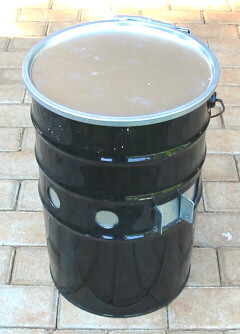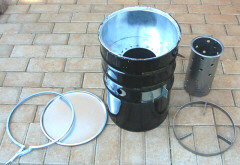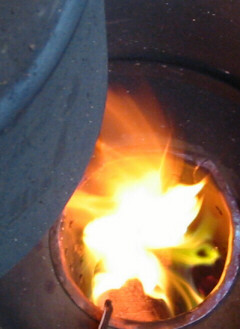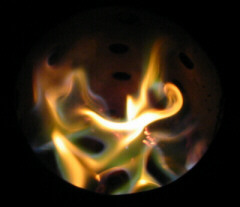 |
SHISA STOVE | |
|
The Shisa Stove is a fuel efficient wood and biomass burning stove made from a standard 25 litre paint can. Shisa means "hot" in SiSwati and several related Nguni languages. This stove is similar to the Basintuthu Stove in that it has preheated primary and secondary air with a single control for both. It is easier to construct and has a better seal for the air at low flow volumes. To operate the air controller, the two handles are squeezed towards each other and they strip with holes in it can easily be slid to the left or right to open or close the air holes. The line of air holes in near the top of the empty space below the pot stand in which heat accumulates as it passes through the secondary air tube. This arrangement provides a greater degree of primary air preheating than the Basintuthu Stove achieves. There is no attempt made to insulate the stove body so that the heat that might eventually be radiated away instead allowed to enter the hollow centre of the stove where it heats the air coming through the holes in the side. There is no attempt made to insulate the stove body so that the heat that might eventually be radiated away instead allowed to enter the hollow centre of the stove where it heats the air coming through the holes in the side. The increased preheating of the primary air (compared with the Basintuthu Stove) allows this unit to burn fuels with a low pyrolization temperature like dung even more efficiently. The stove is designed to use flat-bottomed pots and three legged cast iron pots up to size 2 (2 gallons). The rotating section with holes in it controls the air supply to the whole fire. There is no separate control for the secondary air. A significant amount of variation in fire temperature is possible. The "power phase" of cooking requires far more heat than the "simmering phase". Closing the air control ring reduces the heat output by a factor of 7 or more. The unique construction of this simple stove features primary combustion, secondary combustion, pre-heated primary secondary air injection and significant air control for a remarkable 35% total system efficiency (total available wood heat energy measured against heat delivered into a pot of water). One test by a GTZ consultant in Limpopo Privince of South Africa showed approximately a 33% efficiency when burning dung. The Shisa Stove consists of four components: - the main stove body - the fire grate with holes punched through it - the folded steel strip to support the pots. - the springy flat air control strip on the inside stove body with two protruding handles. |
This picture shows the stove as it is purchased, with a lid and clamping ring, The lid can be used as an ash tray under the stove body. This seals the bottom ensuring that the air controller can perform its function. The Shisa Stove shown here with the lid, clamp, pot stand and fire grate removed.  With the air controller wide open, the smokeless nature of the stove can clearly be seen. Most of the flames are secondary combustion of the smoke produced lower down. The fuel use in this test is pine. The blast of flame with a dark centre on the lower right side of the grate is in fact hot secondary air entering the colourless smoke and igniting it by supplying hot oxygen.  Dung being burned in a Shisa Stove in Ethiopia.  |
|
| << Back | ||